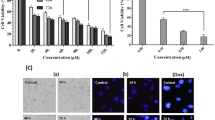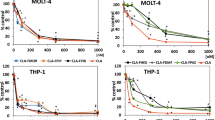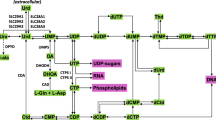Summary
Biochemical studies on a new antitumor antibiotic, CI-920, have been directed toward understanding its mode of action. The most striking effect brought on by CI-920 was a marked inhibition of macromolecular synthesis. L1210 leukemia cells exposed to 10 μM CI-920 exhibited a decreased rate of DNA, RNA, and protein synthesis within 45 min, and maximal inhibition occurred within 60 min. The reduction in nucleic acid synthesis was not due to precursor depletion, since ribonucleoside and deoxyribonucleoside triphosphate levels in cells exposed to 10 μM CI-920 for 2 h either remained unchanged relative to control cells or were elevated, suggesting a block more directly at the level of nucleotide incorporation. Nevertheless, CI-920 (50 μM) had no effect on DNA or RNA polymerase activity as assessed in permeabilized L1210 cells. However, if viable cells were exposed to 20 μM CI-920 for 1 h prior to permeabilization and then the polymerases assayed in the absence of drug, there was a 60% depression in enzyme activity. The inhibition of RNA polymerase appears to result from an effect on the enzyme rather than the template, since inhibition of RNA polymerase activity in cell-free systems from drug-treated cells could not be restored by addition of excess DNA template. DNA polymerase, however, was at least partially restored by addition of template and therefore was inconclusive in this respect. The data, then, suggest that CI-920 inhibits nucleic acid synthesis directly at the level of nucleotide incorporation, either by direct inhibition of DNA or RNA polymerase or by inactivation of an essential component of these enzyme systems. Since the drug in its parent form did not inhibit nucleic acid synthesis in cell-free systems the effects may possibly be mediated through conversion of this agent to another chemical form within viable cells.
Similar content being viewed by others
References
Berger NA (1978) Nucleic acid synthesis in permeabilized eukaryotic cells. Methods Cell Biol 20:325
Fry DW, Boritzki TJ, Jackson RC (1983) Biochemical studies on the novel anticancer agent PD 110, 161. Proc Am Assoc Cancer Res 24:320
Hokanson GC, Stampwala SS, Bunge RH, Hurley TR, French JC (1983) A promising new antitumor antibiotic. Am Chem Soc 186:33
Kohn KW, Ewig AC, Erickson LC, Zwelling LA (1981) Measurement of strand breaks and cross-links by alkaline elution: In: DNA repair: a laboratory manual of research procedures. Marcel Dekker, New York, p 379
Leopold WR, Dombrowski ME, Nelson JM, Roberts BJ (1983) In vivo activity of the novel anticancer antibiotic PD 110, 161. Proc Am Assoc Cancer Res 24:320
Leopold WR, Shillis JL, Mertus AE, Nelson JM, Roberts BJ, Jackson RC (1984) Anticancer activity of the structurally novel antibiotic, CI-920, and its analysis. Cancer Res 44:1928
Linberg V, Skoog LA (1970) A method for the determination of dATP and dTTP in picomole amounts. Anal Biochem 34:152
Lui MS, Jackson RC, Weber G (1979) Enzyme pattern-directed chemotherapy. Effects of antipyrimidine combinations on the ribonucleotide content of hepatomas. Biochem Pharmacol 28:1189
Solter AW, Handschumacher RE (1969) A rapid quantitative determination of deoxyribonucleoside triphosphate based on the enzymatic synthesis of DNA. Biochim Biophys Acta 174:585
Stampwala SS, Bunge RH, Hurley TR, Willmer NE, Brankeiwicz AJ, Steinman CE, Smitka TA, French JC (1983) Novel antitumor agents CI-920, PD 113,270 and PD 113,271. II. Isolation and characterization. J Antibiot (Tokyo) 36:1601
Tunac JB, Graham BD, Dobson WE (1983) novel antitumor agents CI-920, PD 113,270 and PD 113,271. I. Taxonomy, fermentation and biological properties. J Antibiot (Tokyo) 36:1595
Tyrsted G (1975) The pool size of deoxyguanosine 5′-triphosphate and deoxycytidine 5′-triphosphate in phytohemagglutin in stimulated and non-stimulated human lymphocytes. Exp Cell Res 91:429
Author information
Authors and Affiliations
Rights and permissions
About this article
Cite this article
Fry, D.W., Boritzki, T.J. & Jackson, R.C. Studies on the biochemical mechanism of the novel antitumor agent, CI-920. Cancer Chemother. Pharmacol. 13, 171–175 (1984). https://doi.org/10.1007/BF00269023
Received:
Accepted:
Issue Date:
DOI: https://doi.org/10.1007/BF00269023




